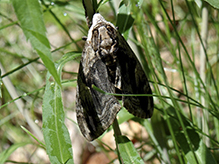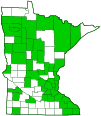elm sphinx
(Ceratomia amyntor)
Conservation • Description • Habitat • Ecology • Distribution • Taxonomy
|
||||||||
| Hodges # | 7786 |
|||||||
Conservation Status |
||||||||
| IUCN Red List | not listed |
|||||||
| NatureServe | N4N5 - Apparently Secure to Secure SNR - Unranked |
|||||||
| Minnesota | not listed |
|||||||
Description |
||
Elm sphinx is a very large sphinx moth. It occurs in the United States and southern Canada east of the Rocky Mountains. It is common in Minnesota. Larvae feed on the foliage mostly of elms and birches but also of basswood. Reports of larvae feeding on cherry may be erroneous. Adults probably do not feed. They are found in June and July in deciduous woodlands and open areas where its hosts occur. Adults are 2″ to 2⅜″ (50 to 60 mm) in length and have a 3¼″ to 4½″ (82 to 115 mm) wingspan. The forewing length is 1¾″ to 1 15⁄16″ (44 to 48 mm). Both sexes are similar in appearance, but females are larger than males. The body is robust. The overall coloration is light and dark shades of brown, grayish-brown, or yellowish-brown. The upper side of the thorax is densely hairy and brown, with dark brown on the front margin and lateral margins. The antennae are pale and are club-shaped at the tip. The abdomen is light brown and tapers in the rear to a point. There is a narrow, black, longitudinal stripe in the middle (middorsal), and a broader stripe on each side. The forewing is long, narrow, and pointed. The outer margin is slightly concave. The upper side is strongly mottled with several shades of light to dark brown. The leading edge (costal margin) is whitish. The basal area is light brown. The median area is light brown on the outer third, dark brown on the inner two thirds, with a small, bar-shaped spot (reniform spot), and a pale patch beyond the reniform spot. The reniform spot is whitish and is not bordered. There are several bold, black dashes along the veins: two long dashes in the median area near the center of the wing, one long dash extending from the lower median area to the subterminal area, one shorter dash in the subterminal area, and two short dashes near the wing tip. From a distance, the overall effect is a dark longitudinal stripe from the wing base to the wingtip. The postmedial (PM) line is represented by three jagged lines with a pale area between them. The hindwing is mostly dark brown but paler at the base. The PM line is similar in width to the one on the forewing, but it is entirely dark. The fringe on both wings is checkered brown and white. The caterpillar is up to 3½″ (9 cm) in length. It may be brown or green, and it has several pale diagonal lines on each side. There is a pair of spiny horns on both the second and third segments of the thorax. This is the feature that gives the caterpillar the common name four-horned sphinx. There is a line of white, scale-like plates down the middle (middorsal), and the entire body is moderately covered with white-tipped granules. |
||
Size |
||
Total length: 2″ to 2⅜″ (50 to 60 mm) Wingspan: 3¼″ to 4½″ (82 to 115 mm) |
||
Similar Species |
||
Habitat and Hosts |
||
Deciduous woodlands and open areas Elm, birch, and basswood |
||
Ecology |
||
Season |
||
One generation per year: June and July |
||
Behavior |
||
Larvae feed on the underside of leaves. |
||
Life Cycle |
||
|
||
Larva Hosts |
||
Foliage of mostly elm and birch but also basswood |
||
Adult Food |
||
Flower nectar |
||
Distribution |
||||
|
Sources |
|||
| 3/18/2023 | ||||
Occurrence |
||||
|
||||
Taxonomy |
|||
Order |
Lepidoptera (Butterflies and Moths) | ||
Superfamily |
Bombycoidea (Hawk, Sphinx, Silk, Emperor, and Allied Moths) | ||
Family |
Sphingidae (sphinx moths) | ||
Subfamily |
Sphinginae (large sphinx moths) | ||
Tribe |
Sphingini | ||
| Subtribe | Sphingina | ||
Genus |
Ceratomia | ||
Synonyms |
|||
Agrius amyntor Ceratomia quadricornis Ceratomia ulmi |
|||
Common Names |
|||
elm sphinx elm sphinx moth four-horned sphinx (caterpillar) |
|||
Glossary
Reniform spot
A kidney-shaped spot or outline in the lower median area near the PM line on the forewing of many moths.
Visitor Photos |
|||||
Share your photo of this insect. |
|||||
| This button not working for you? Simply email us at info@MinnesotaSeasons.com. Attach one or more photos and, if you like, a caption. |
|||||
Luciearl |
|||||
 |
|||||
MinnesotaSeasons.com Photos |
|||||
|
|||||

Slideshows |
||

Visitor Videos |
|||
Share your video of this insect. |
|||
| This button not working for you? Simply email us at info@MinnesotaSeasons.com. Attach a video, a YouTube link, or a cloud storage link. |
|||
Other Videos |
|||
| Ceratomia amyntor (The elm sphinx) Bugs Life |
|||
About
Apr 23, 2021 Ceratomia amyntor, the elm sphinx or four-horned sphinx, is a North American moth in the family Sphingidae. The species was first described by Carl Geyer in 1835. It has a wingspan of 3 ¹⁄₄-4 ¹⁄₂ inches. |
|||
| Ceratomia amyntor or Elm Sphinx Learn with Mr. Weir |
|||
About
Aug 23, 2020 This is a really pretty moth found by students at recess. Join the fun by requesting an account for your class so that you can upload images and videos. You can request a free account at http://educationalresource.org/creepycritters |
|||
| NOW THAT’S A HUGE MOTH! A Elm Sphinx Moth (Ceratomia amyntor) specifically Kahanu Ermeyas-Tulu |
|||
About
Jun 30, 2021 |
|||

Created: 3/18/2023
Last Updated:


